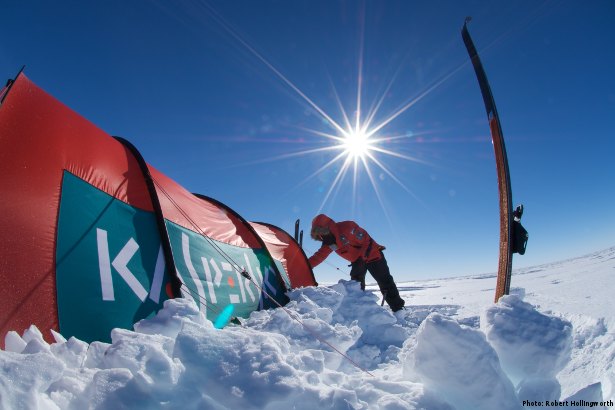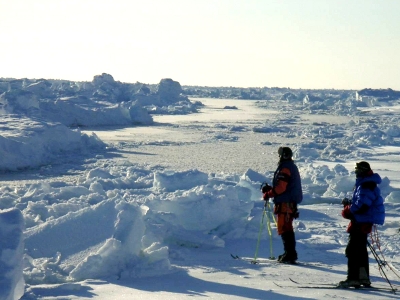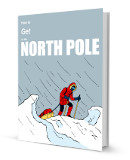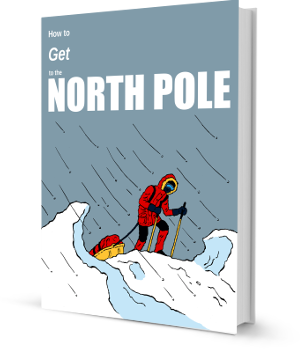This article was first published in 2010.
It has since been used by tens of thousands and made into a full book.
[divide]
How to Get to the North Pole
ebook
[one_third]
[/one_third]
[two_third_last]
“The perfect resource” – Bear Grylls
“An excellent book” – Sir Ranulph Fiennes
“The bible for polar planning” – Conrad Dickinson, Polar Explorer
[divide]
[button color=”blue” link=”http://thenextchallenge.org/books/north-pole” size=”big” fontw=”bold” textcolor=”#fff” align=”center” radius=”3″]Download now ➜[/button]
[divide]
[/two_third_last]
[divide]
Introduction
The guide below explains the different ways of reaching the North Pole and how you go about them.
It clarifies the differences between the four different North Poles, explains the typical difficulties you can expect to face when trying to reach them and details several route choices from the very easy (flying) to the very hard (skiing unassisted).
[divide]
Where is the North Pole?
First, it is worth noting that unlike its southern counterpart, the North Pole does not lie on a land mass but in the middle of the Arctic Ocean. For the most part, it is frozen over and hence, at the right time of year, it is possible to travel there on foot, ski, dog sled or similar.
The question of its location is slightly more complicated than you might assume given that there are a total of four different “North Poles”. Jeremy Clarkson may have been to one of these but he actually finished further south than many North Pole expeditions start.
These explanations should help clear things up:
1. Geographic North Pole
Put your finger on top of the globe and you will be pointing at the Geographic North Pole. This is the goal that early explorers sought after and is often aptly known as “True North”. This is most often what people are referring to when they walk about the North Pole and is the most commonly visited.
- Notable Expeditions: Robert Peary (1909), Roald Amundsen (1926), Wally Herbert (1969), Pen Hadow (2000)
2. Magnetic North Pole
This is where your compass points which is not, in fact, the top of the world as you may have been led to believe. Keen navigators amongst you will understand that this is why you have to adjust your compass readings depending on where in the world you are standing.
To make things even more complicated, the Magnetic North Pole is continually moving and was last seen some way west of north Greenland (see map). However, its position in 1996 is often used as the standard for adventurous outings – partly following an expedition that used various methods to pinpoint it that year and, I suspect, because it’s at a relatively convenient location.
- Notable Expeditions: James Clark Ross (1831), Roald Amundsen (1903), Top Gear (2007)
3. Geo-Magnetic North Pole
This one’s a little more complicated than the others:
Imagine the earth as surrounded by a magnetic field. Like any magnet, this field has a positive and a negative which, in the case of the earth, sit over the geographic north and south poles. There is a line that connects these two points known as a “dipole”. This line is not a straight one and where it touches the earth’s surface at the northern end is what we call the Geo-Magnetic North Pole.
There are far fewer expeditions to the Geo-Magnetic North Pole than there are to the Geographic or Magnetic (perhaps because half of us can’t quite understand the explanation of where it is).
- Notable Expeditions: Rob Gauntlett and James Hooper (2007), Ice Warrior Expeditions
4. Arctic Pole
This is the point in the Arctic Ocean which is furthest from land thus, in theory, making it the most difficult to reach. To get there from the coast would require a crossing of around 800 miles and such a journey has only once been made and with the aid of dogs. This point is sometimes also referred to as the “Pole of Inaccessibility”. (For more detail, see: Has anyone been to the North Pole of Inaccessibility?)
- Notable Expeditions: Sir Wally Herbert (1968)
So how do you know which is which?
Unless otherwise stated, when I say “North Pole”, I mean the Geographic “True” North Pole. In both geographical and adventure terms, I think this is the worthiest claimant for the title. This article, however, will explain how to get to any of the four; each of which can be reached in a number of different ways from easy (dropped off nearby) to very difficult (walking from the coast).
For a more detailed explanation of the different North Poles, you can read the following excerpt from my book ‘Where is the North Pole?‘
But first some definitions…
[divide]
Useful Terms
- Barneo – A temporary Russian base set up every year on the sea ice about 60 miles from the Geographic North Pole. It has a runway on the ice and helicopters at its disposal and is thus used as a stepping stone for many expeditions. Sometimes spelled “Borneo”.
- Pulk – The sled full of equipment and supplies that you’ll likely have to drag behind you
- Sea Ice – The frozen ocean which you will be walking on for the majority of your trip
- Unsupported – An expedition can be called this if it works under its own steam (e.g. walking or skiing) and does not use of things like dogs, kites for wind support or motors
- Unassisted – An expedition can be called this if it is entirely self-sufficient and does not use external help such as having a plane drop off supplies
So, now you understand the four different North Poles that exist and you know a few key terms. But before we dive into your options, it would be prudent to look at some of the reasons that reaching the top of the world can be difficult…
For a full set of definitions, see: The Language of Polar Expeditions.

[divide]
Difficulties Faced
Each of the issues below will affect you to a greater or lesser degree depending on your choice of route. If you get dropped off by helicopter then apart from the cold, you won’t have to contend with many of these. But if you set off solo from the Russian coast with a pair of skis and a pulk then you will face them all in abundance.
1. Dealing with the lack of daylight
The extreme ends of latitude experience extreme hours of daylight. At the time of year that most North Pole expeditions are conducted, you can expect very long daylight hours if not 24 hours of light. That is unless you are going for a full-distance North Pole expedition in which case you’ll probably start in 24-hour darkness.
2. Walking on frozen water
Remember that there is no land mass beneath the North Pole (although the Magnetic North Pole may, at some point in time, move over land) and a journey to any of the four northerly poles will likely be conducted largely on frozen ocean. That means that you run the risk of falling through into sub-zero waters if you don’t know what you’re doing and it can still happen even when you do.
3. Crossing open water leads
As well as the risk of falling through the ice, there are often large stretches of open water that you will have to cross. These have got worse in recent years, a possible sign of global warming. Options for getting past these are to walk around, which can sometimes be very lengthy, swim in a specially made dry-suit or to use a floating pulk that you can paddle across.

4. Navigating on drifting ice
The fact that you are walking on the frozen sea also means that the ground beneath you is moving, whether you can feel it or not. If you left a boat unanchored when you went to sleep you would wake up in a different location the following morning and the same is true for NorthPole expeditions. The effect does not tend be quite as drastic but if you’re really unlucky then you might ski for a whole day only to find yourself further south than you started. Equally, it has been known for expeditions to set up camp a few miles from the pole only to drift over it in their sleep.
5. Coping with the cold
Needless to say, any polar expedition is going to be pretty chilly. Anything from -50C or below in the wind if you start in the February darkness for a full-distance trip, to closer to a balmy -20C or warmer nearer the pole in May. Whilst this might seem like an enemy in many ways, it’s also a friend in that it is what’s keep the ground beneath you solid. If you’re out there too late in the season then you risk getting your feet wet or worse.
5. Getting over pressure ridges
Sadly, the Arctic Ocean is not billiard table flat as you might imagine. As the name hints at, it more closely resembles a choppy sea instantly frozen in place but even that doesn’t explain everything you’ll come across.
As a result of the constantly moving ice and repeated heating and cooling, large ridges and blocks of jumbled ice can form. Sometimes many miles long and up to the height of a two-storey building. And whilst such obstacles might provide an entertaining distraction in another setting, when it’s 40 below and you’re wearing four-foot skis with a 50kg pulk attached to your waist they can require no small amount of effort to pass.
6. Protection from polar bears
Penguins are in Antarctica, polar bears in the Arctic. Unlike other bears, the polar variety will actually hunt humans and are a real threat on the ice. They are also protected and killing one is not something to be done lightly so it pays to be prudent. Defences include carrying a gun and flares, surrounding your tent with a trip wire at night and generally keeping your eyes peeled to avoid close encounters.
7. Finding where the North Pole actually is
To set expectations, please note that unlike the Antarctic equivalent, there is no barber’s pole up north. Instead, you’ll need a GPS to confirm that you’ve reached your destination.
Because of the drifting sea ice, if you plant a pole or flag at the location your GPS tells you is the North Pole (any of them) and sit down for some lunch then you’ll discover that by the time you’ve finished, your GPS reading will reveal a different location. That means no welcome party but does guarantee an entirely unique north pole of your own.
The above difficulties and several others are given more consideration in the book of the same title: How to Get to the North Pole (and Other Iconic Adventures).
[divide]
When to go
North Pole season is between February and May. The key factor is temperature. Go in winter and it is going to be even colder than usual as well as pitch black. But go in summer and the ice will be riddled with leads of open water and dangerous stretches of thin ice, if any at all.
If you’re joining an event or organised holiday you can just check the dates that are offered. These will also be a useful guide if you want to plan your own trip. For those attempting full-distance expeditions, it’s not uncommon for all of the teams in a given year (and there are rarely more than a handful) to start within a week or so of each other, often sharing flights to save costs.

[divide]
[divide]
How to Get There
1. Flying to the North Pole
If you have enough money then you can fly to any of these locations. The most common method is flying first to the Svalbard archipelago halfway between the top of Norway and the North Pole and then on to the Barneo ice station where you can take a helicopter for the final 60-odd miles to the Geographic North Pole. This should cost in the region of €10,000. For considerably less money, you could take a sightseeing flight that passes over the North Pole without actually landing there.
Alternatively, the Canadian airline Kenn Borek offers charter flights to most locations across the Arctic Ocean including the North Pole. They don’t come cheap though, especially when you get further north and the journey requires a second plane to refill the first one half way. Expect to pay in the region of £250,000 for a return flight to the Geographic North Pole from Canada.
This option requires no training or expertise, just a big down jacket and an even bigger cheque book.
2. Entering the North Pole Marathon
For about €12,000 you can enter “The World’s Coolest Marathon”. The race actually occurs at the Barneo station a short flight away from the Geographic North Pole but that’s thrown in with the bundle after you finish running.
This might sound a little extreme but will require infinitely less expertise than most of the other options here as you’ll be supported the whole time and will only be on the ice for a few hours. It would of course pay to get fit enough to run a normal marathon first and pack some woolly socks.
3. Joining a polar race
There are two organised races to the Magnetic North Pole – The Polar Challenge and the North Pole Race. They start from Resolute Bay in the northern Canadian region of Nunavut and take you 300 miles or so over frozen ocean and a few islands on the way.
Similar to an organised Last Degree trip (below), this is a great way to get a taste of a “real” polar expedition without the high levels of expertise and even higher levels of money required for a full-distance expedition. You will still need to stump up tens of thousands and spend several weeks hauling a pulk in sub-zero temperatures but you gain the confidence of going through a training programme and having some degree of support on the ice.
It is quite possible to organise your own expedition to the Magnetic North Pole along a similar route and a trip to the Geo-Magnetic North Pole would be in a similar bracket of difficulty.

4. Skiing the Last Degree
The Geographic North Pole is located at 90-degrees north and it’s possible to be dropped off in a plane or a helicopter from Barneo at any point between land and that point. A common location, however, is getting a lift to the 89th degree which will leave you with about 65 miles to ski. An itinerary known as “the Last Degree”.
As with any of these trips, it is possible to organise it yourself but there are many companies that will arrange things for you, have groups that you can join or will at least provide a guide. Organised itineraries tend to be around the €20,000 mark and are offered by many companies including Svante Strand’s Newland, Borge Ousland, Charlie Paton’s Extreme Outdoor Adventure, most of the companies mentioned elsewhere in this article and many more on Google.
This is in a similar bracket to the races above in that you get exposed to genuine polar travel whilst avoiding some of the extremes of a full-distance trip. The differences are that it will be shorter than the races, there’s isn’t an inherent competitive element, you won’t be part of a larger event (which has good points and bad) and you finish at the Geographic North Pole rather than the Magnetic.
5. Completing a full distance North Pole expedition
This type of expedition sits head and shoulders above the rest in almost every respect. It is the toughest of the lot by a long way and, in my opinion, one of hardest set piece expeditions out there.
(N.B. Most of the details for a full-distance trip can be applied to one aiming for the Arctic Pole. It will just be a little bit further for you.)
For this trip, you will start from the coast of either Russia or Canada (most likely Cape Arktichevsky or Ward Hunt Island respectively), reached by a plane that you will have to charter. From there you travel overland (or rather over frozen sea) all the way to the Geographic North Pole in the region of 500 miles away.
The most common way to travel is by ski as this is faster than walking and spreads your load out over a greater surface area making you less likely to fall through the ice. Snow shoes have been tried too. Alternatively, you could use dog sleds or skidoos.
You can expect to be on the ice for between 36 days (the current record) and upwards of double that. So you either need to take a very large pulk (or two tied end-to-end as some have been known to do) or arrange a re-supply by chartering another plane.
You will have to start early in the season to maximise good ice conditions under foot meaning that you get the coldest of the weather and will likely begin in 24-hour darkness.
If you make it to the top then unless you do so swiftly enough to catch the helicopter pilots at Barneo before they remove the camp for the season, you will have to charter another plane to pick you up making this an incredibly expensive expedition to complete.
Apart from the rigours of surviving and travelling in such an environment, you will want to have a good degree of experience on sea ice before attempting such a journey. There are a few unique people who offer guiding services for this trip which can be sought directly or through companies like Adventure Consultants and Polar Explorers, and there is rumour of an organised race starting.
[divide]
What Next?
You know where the different poles are and you’ve got a grip on all the different options for getting to them as well as some of the difficulties you might come up against. So now you need to get used to pulk-hauling (by dragging tyres), familiarise yourself with a cold environment (Europeans, try Scandinavia), sort out the funds (advice here) and pack your bags.
And remember to pack a GPS so you know when you’ve arrived…
[divide]
DOWNLOAD THE COMPLETE EBOOK NOW
How to Get to the North Pole
[divide]
[one_third]

[/one_third]
[two_third_last]
“The perfect resource” – Bear Grylls
“An excellent book” – Sir Ranulph Fiennes
“The bible for polar planning” – Conrad Dickinson, Polar Explorer
[/two_third_last]
[divide]
[button color=”blue” link=”http://thenextchallenge.org/books/north-pole” size=”big” fontw=”bold” textcolor=”#fff” align=”center” radius=”3″]Click here to get your copy ➜[/button]
[divide]

What do you think? Please do add your thoughts below…